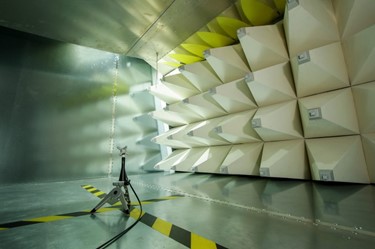The Truth About EMC & EMI Testing

By John Oncea, Editor

There’s a lot for electronic designers to consider when designing a product or system, including electromagnetic compatibility (EMC) and electromagnetic interference (EMI).
Regulatory bodies worldwide have implemented electromagnetic compatibility (EMC) and electromagnetic interference (EMI) standards to improve the safety and dependability of electrical and electronic equipment for users. These standards aim to limit any unwanted emissions a device can generate, with the primary aim of preventing interference with nearby TV or radio receivers. Failure to comply with EMI/EMC regulations may result in penalties, seizures, or recalls of the product.
Let’s dig into what EMC and EMI are, as well as why testing is so critical. There are four kinds of EMI – undesirable noise in a system that disrupts electronic, electrical, and RF systems – according to Electronic Design:
- Conducted EMI: This type of EMI, which flows through wires, occurs via physical contact with the source of that EMI.
- Differential-mode EMI: This low-frequency EMI will flow in the opposite direction through adjacent wiring.
- Common-mode EMI: This high-frequency form of EMI flows in the same direction through one or more electrical conductors.
- Radiated EMI: This is the most common type of EMI. It’s caused by radiating electromagnetic fields. Common signs of radiated EMI include “snow” on TV monitors and static noise on AM/FM radio receivers.
EMC of an electrical, electronic, or RF device has two features:
- The capability of working properly while in the presence of electromagnetic radiation.
- The capability to not generate any additional EMI that may affect the proper operation of any other devices nearby.
To enhance the EMC of any device, a well-planned design, and shielding in addition to EMI filtering can be utilized. Compliance testing can be conducted to measure a device's EMC through a specialized test system comprising antennas, near-field probes, and spectrum analyzers.
Electronic Designs summarizes the two by writing, “EMI isn’t a desirable phenomenon, and EMC is a set of practices and rules that will control it. Without EMI, EMC isn’t necessary; without EMC, EMI will ultimately cause design problems.”
Time For A Test
It is crucial to conduct EMI and EMC testing to ensure that a device can function correctly in its intended surroundings and meet the necessary standards. Specialized test facilities or test houses typically perform pre-compliance and compliance testing, although some companies have integrated pre-compliance testing capabilities in-house. Compliance testing for EMI/EMC necessitates the use of methods, equipment, and measurement sites that meet national or international standards. National and international standards for compliance are defined by individual nations and may differ.
EMI and EMC testing can, according to Premier EMC, be categorized into the following categories: emissions testing and immunity testing. “Emissions testing measures the amount of electromagnetic noise generated by the device. The purpose of emissions testing is to ensure that emissions from the device are below the defined limits to ensure that the device will not cause any harmful interference to other devices operating within its expected operating environment.
“When a device is exposed to electromagnetic noise and other disturbances, immunity testing measures its reaction. The purpose of immunity testing is to assure that the device will perform the desired operation when used within its expected operating environment.”
It's important for companies creating electronic devices to prioritize EMC compliance. Many countries have established regulations regarding EMI and EMC to ensure the safety and reliability of users of electrical and electronic equipment. Regulatory agencies have established guidelines for the maximum amount of unwanted emissions that can be produced by a device, with the main objective being to avoid interference with nearby TV or radio receivers. Failure to meet these regulations can result in penalties, seizures, or even product recalls.
